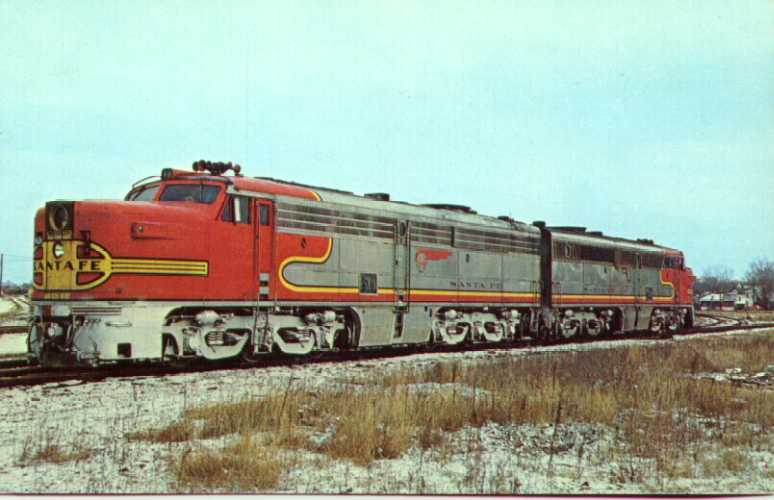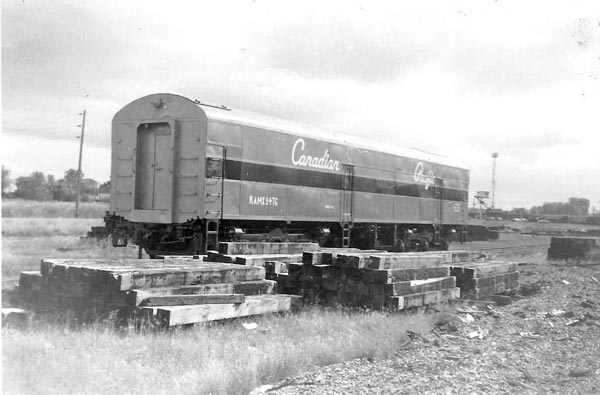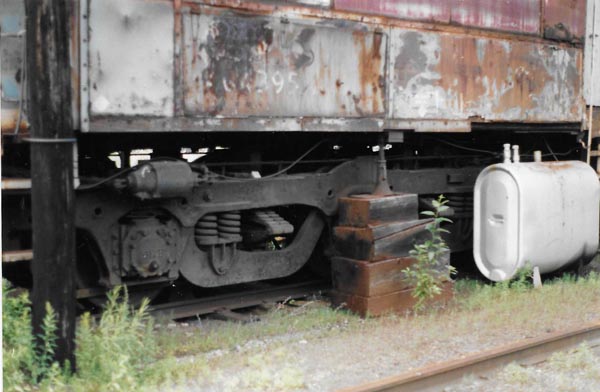
Big Emma #1976. Part of a third production batch built in 1949, all of them were retired by 1956. The locomotive number on the headlamp lense was an L&N hallmark

Big Emma #1976. Part of a third production batch built in 1949, all of them were retired by 1956. The locomotive number on the headlamp lense was an L&N hallmark
I love the history that I am learning in this thread. As a kid I always thought they were cool, never got to experience any first hand as a child, (some classic Trolley cars from the TTC but that's a different story). Keep this stuff coming!!




Pretty excited to see this one. Recently they have started working on restoring a Nashville, Chattanooga & St. Louis J-3 "yellowjacket" to operation. In '53, after the NC&StL retired all their J-3s, they donated the #576 to Nashville to display at Centennial Park.
The engine was actually previously selected for restoration a few times. Once was in the 1970s, when the American bicentennial American Freedom Train was being planned and the #576 was considered for the eastern seaboard leg, but was felt to be too light and Reading #2101 was selected instead. Then in the mid '70s, the Southern Railway looked at the #576 for an excursion program but Nashville locals pushed back against the idea of #576 leaving the city.
In the late '70s, the Seaboard System/Clinchfield Railroad were looking for a modern large steam locomotive for their steam program, as they were using a very old, tiny 4-6-0, but again Nashville resisted. Seaboard/Clinchfield would instead lease C&O #2716 and begin restoration, before the program fell apart and it instead went to Southern Railway who restored it to operation. Shortly afterwards, Nashville changed their mind and offered the #576 to Clinchfield but it was too late.
The current plan is to restore it to operation on the Nashville & Eastern

Fun fact: the #576 was the locomotive that Johnny Cash posed with for an album cover.
Also interesting: As a proud southern railroad, the Nashville, Chattanooga & St. Louis didn't call their J-3 4-8-4s a "Northern", instead calling them "Dixies"
Also: You could not get to St. Louis aboard the Nashville, Chattanooga & St. Louis.

McGinnis might have run the New Haven into ruin, but damn, if he didn't come up with a flashy new livery. I also always thought it was odd that the New Haven prefaced their 3-digit locomotive numbers with a 0.

There was also the reddish orange, with a dark green roof and white pinstripes. I recall reading that at one point, New Haven had 11 liveries on their passenger diesels.

An Alco PA in demonstrator livery. Why the GE lettering? During the early days, GE concentrated on switcher locomotives of various weights, but decided to partner with an existing manufacturer for large over-the-road engines. EMD already had their own electricals, so GE partnered with Alco, who appeared to be the best competitor. Unfortunately, the rushed engine development on the Alco 244 engines led to mechanical trouble that hurt their reputation. GE got sick of Alco's sliding sales and jumped in as their own manufacturer, although they still sold electrical components to Alco, just not the top-shelf parts. Ironically, later Alcos had the much improved 251 engine that eliminated most mechanical troubles, but were now held back by the lesser quality GE parts. GE's entry to the locomotive market shut the door on Alco and they ceased to exist in 1969, with their Canadian branch soldiering on until 1985 before closing up shop.
Not many Alco PAs are left these days. And they have a pretty odd story. They started life operating on the Santa Fe and ran there until the early 1970s.

After their retirement, the Delaware & Hudson snapped the 4 of them up and had them overhauled by Morrison-Knudsen with 251 engines and pressed them into passenger service. D&H was building a bit of a heritage fleet at the time, having aqcuired the last two Baldwin RF16s, and ran them from 1975 to 1978

They then were sold off in 1978 after a change in management and went south to the Nacional de Mexico. As seems to be a common thread, the NdeM then ran them into the ground, with all but one of them being out of service by 1981 and one of them being wrecked badly. After that, they kind of fell off everyone's radar, assuming they were scrapped.

In the early 2000s, a gentleman by the name of Doyle McCormack, kind of a go-to guy and all-around badass in the field, learns that all of the Alco PAs still exist. Mexico had put one on display, and had one operating again, but the other two were sitting in a yard, stripped of parts and little more than scrap. McCormack, working with the Smithsonian, manages to work out a deal and get them back to the US, with one, the wrecked D&H #16, going to the National Museum of American History, and the other, #18, going to him.
McCormack decided to restore #18 as Nickel Plate #190, as NKP #190 was the first locomotive he ever rode in as a kid, and he's getting very close to having it fully operation, with the plane to run it with restored NKP Berkshire #765 as protection power.

While #16 originally went to the Smithsonian for cosmetic repairs, the Smithsonian has since donated to the Museum Of The American Railroad, who plans to restore it to it's original Santa Fe livery and operate. A big job, considering it was the crashed, stripped hulk above. No photos of it since then, but they are accepting donations
Of the other 2, one is supposedly still operational as a heritage unit in Mexico in N de M colors, and the fourth they have displayed in Southern Pacific colors in Mexico. Photos and info from that part of the world are a little hard to get. There is also a booster unit somewhere in the US, but stripped of engines and converted to a steam heat generator for passenger use. And a weird wide-gauge unit in Brazil that they sold 3 of, but again, hard to find info on.

Wow, dug around and found a photo of the Brazilian broad-gauge Alco PA. Whoa, she is rough. Apparently, the only difference between a regular PA and these was the trucks, so in theory you could swap a set of standard-gauge trucks on and it'd run on American rails. Except for the part where it's in Brazil and has no prime mover or anything. Back in 2014, someone began an effort to try and ship it up to the US. Doesn't seem like it got anywhere.

The cab of another of the Brazilian units. The rest of it was scrapped and the cab was used for a restaurant that was never finished.
The interesting thing about the Alco PA restoration was where the trucks came from. Alco PAs use an A-1-A truck (3 axles, outer two are powered, center is non-powered) that were a bit unique. EMD E-series locomotives used an A-1-A truck, but different brand. The Alco PA's GSC trucks were used on less common stuff, like Alco PAs, Baldwin DR-series and Fairbanks-Morse C-Liners and Erie-Builts. All pretty exotic stuff that is no longer in existence. When the Alcos came back to the US, the trucks on them, like the rest of the units, were absolutely destroyed. And you can't just call up and order a set from Rock Auto.
Enter a Canadian Pacific welded rail "factory" in Smiths Falls. In 1968, the Canadian Pacific bought 4 ex-PRR Fairbanks-Morse Erie-Built B-units. B-units are a locomotive with no cab or controls, just traction motors, engines and generator, designed to be hooked behind an A-unit and operated in series.

The Canadian Pacific then gutted the engines and generators from all of them and mounted machinery inside, as well as adding windows and doors and cupolas and roof extensions and exhaust pipes and all sorts of widgets.



One car polished the rails, then it went into the next which welded and trimmed the rail, the next was for grinding and inspection and then the last was the power plant for the whole assembly and then it came out the end as a continuous 1,440 foot welded rail segment to eliminate joints.
In the 1990s, CP built a new proper facility and retired this Frankenstein rail "factory" and began cutting them up for scrap. Three of the four were scrapped on shut down and another hung around as late as 2010 before being cut up. A bit sad, as these were the last known components of F-M Erie-Builts. Every other A and B-unit had been long since scrapped. But, going back to the top, F-M Erie-Builts used the same GSC A-1-A trucks as an Alco PA. And these were still intact, with traction motors, and relatively undamaged.


For some reason, the trucks from the three cars scrapped in 1993 had been set aside (the Canadian railroads loved Alco equipment, so it might have been set aside for that, or it might have just been a packrat mentality) and Doyle McCormack learned of them when he repatriated the Alco PAs. He made some calls purchased 2 of them for himself and 2 for the Smithsonian's restoration effort. The third set languished for some time in storage until fees became excessive and then were cut up as well, although by all accounts that set was beat to hell and back. The trucks from the remaining car scrapped in 2010 were not saved.

Alco's earlier unit, the DL109, was also a pretty handsome locomotive as well, although perhaps a little too similar in appearance to an early EMD E-series. No DL109s survived.

Rock Island kept a single DL109, the #621, operating far later in life than most other railroads, although they yanked the original Macintosh-Seymour 539 powerplant for a much more reliable EMD 567
You'll need to log in to post.